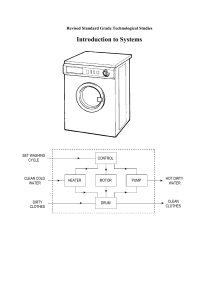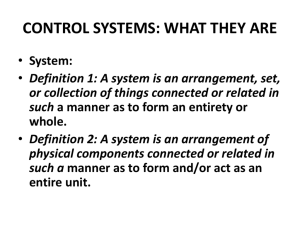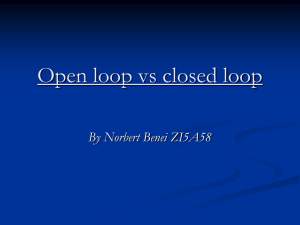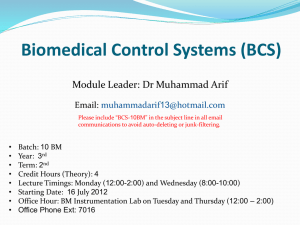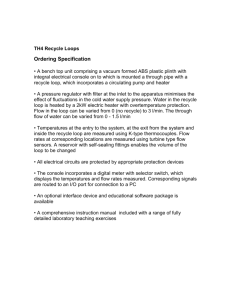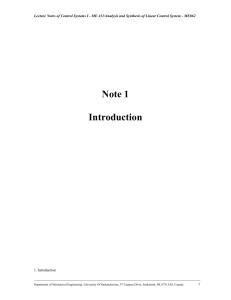Systems - Earlston High School
advertisement
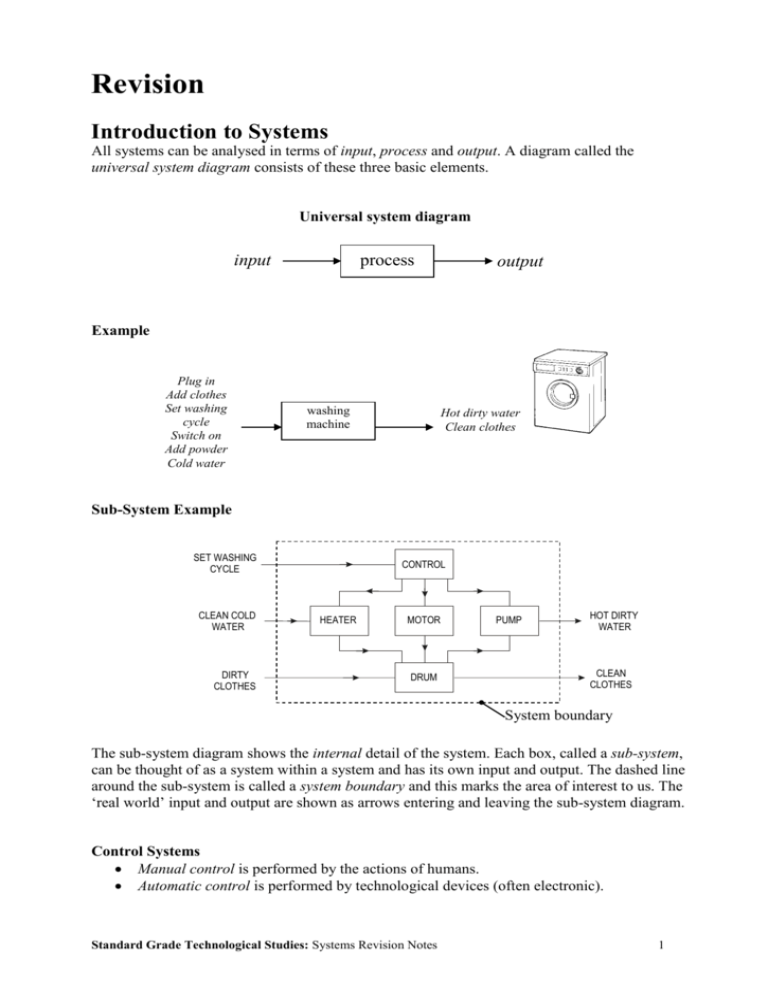
Revision Introduction to Systems All systems can be analysed in terms of input, process and output. A diagram called the universal system diagram consists of these three basic elements. Universal system diagram input process output Example Plug in Add clothes Set washing cycle Switch on Add powder Cold water washing machine Hot dirty water Clean clothes Sub-System Example SET WASHING CYCLE CLEAN COLD WATER DIRTY CLOTHES CONTROL HEATER MOTOR DRUM PUMP HOT DIRTY WATER CLEAN CLOTHES System boundary The sub-system diagram shows the internal detail of the system. Each box, called a sub-system, can be thought of as a system within a system and has its own input and output. The dashed line around the sub-system is called a system boundary and this marks the area of interest to us. The ‘real world’ input and output are shown as arrows entering and leaving the sub-system diagram. Control Systems Manual control is performed by the actions of humans. Automatic control is performed by technological devices (often electronic). Standard Grade Technological Studies: Systems Revision Notes 1 Open Loop Control In the hairdryer the heating element and fan motor are switched on when the appropriate switches are held down. This is shown on the sub-systems diagram below. Switch on Electrical energy Set temperature level on/off control sub-system motor Cold air fan Sound energy Heater only on when switched on heat control sub-system heating element Hot air Here the input signal from the on/off and temperature switch is processed to produce the output. The output air is not monitored or adjusted in any way and it is just blown out at whatever temperature the heater warms it to. An open-loop control system is the simplest and cheapest form of control. However, although open-loop control has many uses, its basic weakness lies in its inability to adjust the output to suit the requirements. Closed Loop Control This is the most sophisticated form of control. In closed-loop control the value of the output is constantly monitored as the system operates and this value is compared with the set (or reference) value. If there is any difference between the actual value and the set value (an error), then the input to the system is varied in order to reduce the output error to zero. Closed-loop control is a more accurate system of control and at the same time more expensive. It employs self-monitoring, where a sensor is used to read the condition being controlled and adjust the output if necessary. This monitoring takes place through a feedback loop. Here an input sensor checks the output and adjusts it when it does not meet the requirements. Example below is for a fan heater. Set temperature thermostat Switch on Electrical energy 2 on/off control motor fan heater Hot air at required temperature A closed-loop system can always be identified by the presence of a feedback loop. An open-loop system never has a feedback loop. Standard Grade Technological Studies: Systems Revision Notes Negative and Positive Feedback The purpose of closed-loop control is to ensure that the output is maintained at, or as closely as possible to, the desired level. In the case of a central heating system, a graph of the temperature in a room might appear as below left: TEMPERATURE ACTUAL TEMPERATURE ACTUAL SOUND SIGNAL SOUND SIGNAL REQUIRED SOUND SIGNAL SET TEMPERATURE TIME Negative Feedback TIME Positive Feedback As can be seen from the graph (above left), the control system is constantly trying to pull the temperature of the room back towards the set temperature level by reducing the error. This type of control uses negative feedback to reduce the error. Reinforcing or increasing the error can create the opposite effect, for example in a public address system when the microphone is held too close to the speakers. The amplified sound is then picked up, re-amplified and so on. The net result is a high-pitched sound caused by the feedback and this can be represented by the graph above right: This is an example of positive feedback where the error is increased. Although positive feedback does have some useful applications, negative feedback is far more widely used in control systems. Error Detector The error detector symbol, shown right, is included in control diagrams. The error detection symbol is also used to indicate that the control involves two signals. se tva ul e The feedback signal is connected to the negative symbol to indicate the use of negative feedback + _ e rro r s gi n a l ac tu a lva ul e All closed-loop control systems include an error-detection function. In manual closed-loop control systems the brain is the error detector. In automatic closed-loop control systems the error detection is usually performed electronically by a device called an operational amplifier. Control Diagram When working with control systems instead of using a sub-systems diagram a control diagram may be drawn. The control diagram for the automatic heater is shown below. Switch on cold Set level Electrical energy temperature Darkness sensor sensor + control sub-system output driver Standard Grade Technological Studies: Systems Revision Notes heater Room heated automaticall y 3

